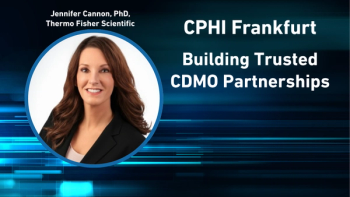
- Pharmaceutical Technology-12-02-2005
- Volume 29
- Issue 12
Competing for the Development Dollar
CROs and CMOs are pursuing new strategies to win a larger share of the burgeoning early development pipeline.
As the early-development pipeline has grown, so has competition among contract-services providers for early-development projects. According to some industry statistics, the number of candidates in Phase I has grown by 50% in the past four years, and the number of Phase II candidates is up nearly 25%. Pharmaceutical industry research and development expenditures continue to rise at nearly 15% annually, so there is plenty of business to go after.
Jim Miller
Competition for early chemistry, manufacturing, and controls (CMC) development business is increasingly setting contract reseach organizations (CROs) against contract manufacturing organizations (CMOs). CROs such as aaiPharma (Wilmington, NC,
The competition is giving rise to competing business models built on integrating clinical supply-chain activities or manufacturing process development activities. The goal is to offer clients either a fast, seamless path to proof-of-concept, or a smooth, tech transfer-free path to commercial-scale manufacturing.
The following four business models are based on greater or lesser degrees of supply chain and process development integration (see Figure I).
Figure 1: Evolving CMC business models.
Integrated clinical supply chain. This model offers clients a simplified, accelerated path from the bench to the clinic. Companies presenting an integrated clinical supply chain solution offer a "one-stop shop" with process development and clinical-trial material (CTM) manufacturing for the drug substance and drug product, analytical testing, and clinical packaging and distribution. These recent efforts differ from previous failed efforts (notably Oread) because the companies now are building an information technology platform to tie the management and tracking of the services. The most avowed proponent of this approach is Aptuit (Greenwich, CT,
Integrated process scale-up. Contract API and dose manufacturers are offering to accelerate the transition from bench-scale to commercial-scale manufacture by providing early development and manufacturing services. Typically, the offering includes process development, CTM manufacture, and analytical services, but not secondary clinical packaging and distribution. In addition to enabling CMOs to form client relationships earlier, this strategy enables them to leverage proprietary process and drug delivery technologies that might keep the client captive. The strategy may have additional advantages as the amount of process research expands in response to process analytical technology initiatives.
Contract-dose manufacturer Patheon (Toronto, Canada,
Turnkey product. Several biomanufacturers have begun offering dose-formulation and manufacturing services as a means of enticing early-stage companies to work with them. The approach promises to speed development and reduce vendor search and management costs by offering a single manufacturer for all of the client's needs. Biomanufacturers are not widely promoting this offering because most have limited capacity and limited dose manufacturing experience. Only a small portion of clients seems interested in the offering, no doubt recognizing that few manufacturers are equally competent in all manufacturing technologies.
Category killer. Although the first three business models integrate elements of the supply chain and process development processes, the category killer model is used to focus on individual activities. The advantage comes from offering clients benefits from economies-of-scale and specialization. As such, the category-killer model appeals more to major pharmaceutical companies that have large volumes of activity. These companies can take advantage of the economies and make it worthwhile to integrate individual vendors into their supply chains.
Central laboratory services from industry leaders such as Covance (Princeton, NJ,
These four business models are not necessarily directly competitive—each offers a somewhat unique value proposition that will appeal to distinct client segments. For instance, the category-killer model best fits major pharmaceutical companies, although the integrated clinical supply-chain model will have particular appeal to early-stage companies looking to out-license a candidate after getting initial proof-of-concept. The process scale-up model would be a good fit for early-stage and virtual companies looking to maintain ownership of their products all the way to commercialization.
The emergence of four distinct strategies, pursued by companies with the financial sources to back them (with acquisitions and capital investments to expand their capabilities), is a clear sign of the growing maturity of the CMC development market.
Jim Miller is president of PharmSource Information Services, Inc., and publisher of Bio/Pharmaceutical Outsourcing Report, tel. 703.383.4903, fax 703.383.4905,
Articles in this issue
about 20 years ago
Growing Freedom, Growing Responsibilityabout 20 years ago
Essentials of Validation Project Management Part Iabout 20 years ago
Too Little and Too Muchabout 20 years ago
The Eighth Annual International Employment Surveyabout 20 years ago
Companies, Courts, and the Cutter Caseabout 20 years ago
FDA Moves to Streamline CMC Review, Promote Drug Qualityabout 20 years ago
December 2005about 20 years ago
In VivoNewsletter
Get the essential updates shaping the future of pharma manufacturing and compliance—subscribe today to Pharmaceutical Technology and never miss a breakthrough.





